FREE shipping on orders over $49!* Details
- All Products
- Outdoor
- Pool & Spa
- Hot Tub & Pool Supplies
- Pool Cleaning Supplies
Pool Cleaning Supplies
67 Results
Sort by:
Price
67 Results
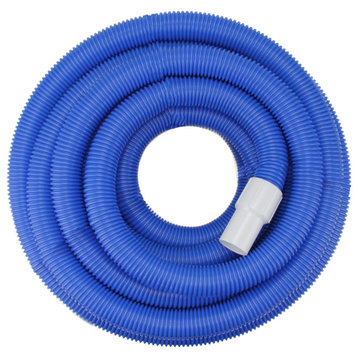
Blue Blow-Molded PE In-Ground Pool Vacuum Hose Swivel Cuff 25' x 1.5"by Pool Central
$32
Free Shipping
Designed for water disposal during vacuum cleaning, this hose is made of a quality plastic that holds up to extreme weather. Use a swivel cuff to prevent tangles! Vacuuming your pool walls keeping your water clear making this hose essential, especially during pool opening. Each hose rolls up neatly for storage and fits most standard vacuum heads.
Features:
- Poly-welded PE cuffs
- Threaded swivel cuff for kink-free maneuverability
- Superior tensile strength for crush-resistant operation
- Lightweight, flexible and it floats
- Dimensions: 25' long x 1.5" diameter
- Material(s): heavy duty PE plastic
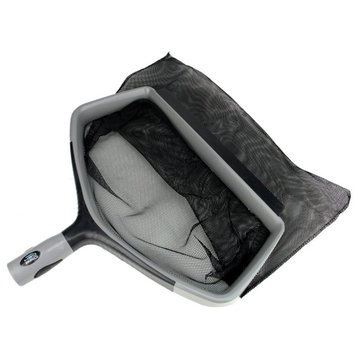
17.5-Inch Gray & Black Swimming Pool Deep Bag Leaf Rake Skimmer Headby Swim Central
$48
Clean your swimming pool easily using this leaf rake. The heavy-duty leaf rake scoops out leaves bugs and other debris from your swimming pool pond hot tub fountain or large fish tank. It also has a secure quick telescopic pole connection so make your life easier. Product Features:
- Deep bag leaf rake skimmer head
- The skimmer head is gray and black
- Heavy-duty deep bag leaf rake
- Rake has wide mouth design and soft scoop edge
- Ease adapt handle fits standard 1.25 inch poles
- Durable long wearing fine-mesh net for capturing finer debris Dimensions: 12"H x 17"W x 17.5"D Material(s): plastic/nylon
Best Seller
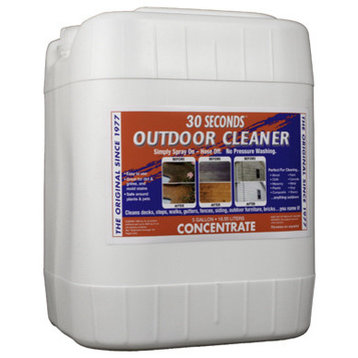
30 Seconds® 5G30S Outdoor Concentrated Cleaner, 5 Gallonby Collier Manufacturing(16)
$91
Free Shipping
Cleans stains from algae, mold and mildew. Just spray on and hose off! No more pressure washing. Safe to use around your lawn and plants when used as directed. Breaks down once rinsed into the soil.
- Size: 5 gallon (18.92 liters)
- Concentrate
- Cleans stains from algae, mold and mildew
- It's clean, when you want it clean
- Just spray on and hose off! No more pressure washing
- Safe to use around your lawn and plants when used as directed
- Breaks down once rinsed into the soil
- Works on a variety of different surfaces: wood decks, concrete sidewalks, asphalt driveways, brick walls, most canvas awnings, plastic outdoor furniture and vinyl siding...just to name a few
- Made in the USA.
- Additional Info
- It works on a variety of different surfaces: wood decks, concrete sidewalks, asphalt driveways, brick walls, most canvas awnings, plastic outdoor furniture and vinyl siding...just to name a few. If it's outdoors and dirty from all your humidity or wet weather, 30 Seconds® Outdoor Cleaner can clean it all.
- Concentrate Formula
- Mix 1 part 30 Seconds® Outdoor Cleaner with 1 part water. For example: Mix 1 gallon of cleaner with 1 gallon of water
- FAQs
- What is the dilution ratio? How much water do I add?
- Concentrate needs to be mixed 1:1 with water. For example 1 gallon of 30 Seconds® Outdoor Cleaner is mixed with 1 gallon of water.
- How do I apply 30 Seconds® Outdoor Cleaner?
- Use a pump or tank sprayer for larger jobs, such as cleaning decks, siding and driveways. These give the best coverage and saturation. You can also use the quart sized product for smaller jobs. It comes with the traditional trigger sprayer which is mixed and Ready-To-Use.
- Is 30 Seconds® Outdoor Cleaner safe to use around plants or landscaping?
- Yes. Just rinse the foliage or grass with water within 10 minutes. 30 Seconds® Outdoor Cleaner breaks down when you rinse it into the soil.
- Is 30 Seconds® Outdoor Cleaner safe around pets?
- We always recommend putting the pet away while you are doing the cleaning. Once the surface is rinsed and dry, it is safe for the pet. If the pet accidentally gets sprayed or walks through the cleaner, rinse thoroughly.
- Can I use 30 Seconds® Outdoor Cleaner on composite decking?
- Yes, 30 Seconds® Outdoor Cleaner works great. Follow the directions on the label. And always remember to rinse well when you are done.
- Will 30 Seconds® Outdoor Cleaner remove the stain from my deck?
- Stain is not colorfast so it will remove the stain particularly where there is residual stain that hasn't penetrated completely upon the initial application of the stain. 30 Seconds® Outdoor Cleaner is great for prepping the surface prior to painting, staining and varnishing.
- Can I use 30 Seconds® Outdoor Cleaner around our drinking water reservoir or pools?
- 30 Seconds® Outdoor Cleaner is a formulated cleaner and should not be allowed to enter drinking water reservoirs, lakes or streams. Swimming pool surrounds are fine to use 30 Seconds® Outdoor Cleaner, however, precaution must be taken to minimize over spray that could actually enter the pools or ponds.
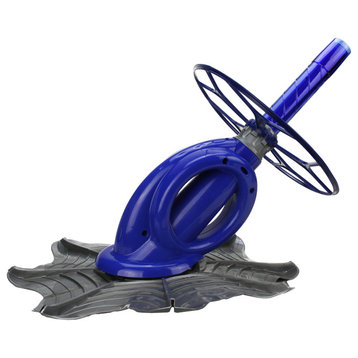
Automatic In-Ground Swimming Pool Cleaning Systemby Northlight Seasonal
$209
Free Shipping
Use this automatic cleaner for stress-free pool cleaning. This quiet attractive automatic in-ground swimming pool cleaner is designed for simple silent operation and low-cost maintenance. The large wheel deflector keeps the cleaner from getting caught on steps ladders or corners so it can continue cleaning the pool. This cleaner keeps your pool clean while relieving you of the burden of everyday manual vacuuming. Product features:
- Quiet attractive and efficient design
- Large intake throat assures removal of large and small debris
- Extra large wheel deflector enables enhanced agility for negotiating tight corners steps and ladders
- Water pressure regulating valve to ensure the ideal travel speed for more thorough cleaning
- Includes 10 extruded hoses
- Ideal for in-ground pools of all types and sizes
- Work flow: 4.5 meters cubed/h Dimensions:
- Hose: 40" long x 2" diameter (per hose)
- Cleaning disc: 18" diameter
- Cleaner (without disc): 21" long x 6" wide Material(s): plastic
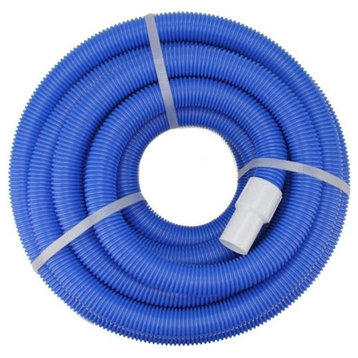
PE in-Ground Pool Vacuum Hose With Swivel Cuff, 300"by Pool Central(149)
$43
- Poly-welded PE cuffs
- Threaded swivel cuff for kink-free maneuverability
- Superior tensile strength for crush-resistant operation
- Lightweight flexible and it floats
- Dimensions: 25' long x 1.5" diameter
- Material(s): Heavy duty PE plastic
Best Seller
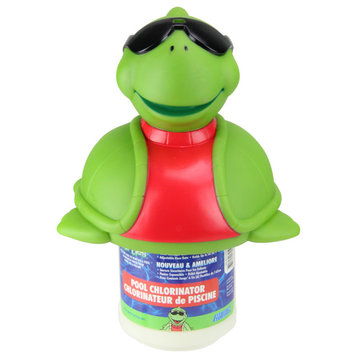
11.5" Turtle With Sunglasses Floating Swimming Pool Chlorine Dispenserby Pool Central(2)
$34
Finally summer is here! You have just opened your pool or spa and oh no what is that your boring old chlorine dispenser is broken? Well add this unique chlorine dispenser to your pool for a shockingly clean pool. Features a smiling happy turtle wearing sunglasses
- Small matching floating turtle is included
- Holds up to (6) 3" chlorine or bromine tablets
- Adjustable chlorinating-control on bottom of dispenser
- Expandable basket for chlorine tabs
- Child-resistant lock Dimensions: 11.5"H x 8.5"W x 8"D
- Material(s): Plastic
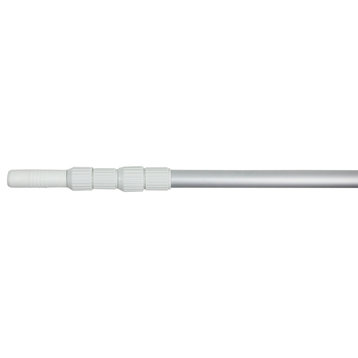
12' Adjustable Silver Swimming Pool Telescopic Pole for Vacuums and Skimmersby Northlight Seasonal(6)
$57
Free Shipping
Keep your pool clean and safe with this helpful aluminum telescopic pole! Easily keep your pool clean by easily attaching brushes and skimmers to this handy pole this summer! Features:
- Adjustable length - expands from 5 feet to 12 feet
- Easy twist to expand the length of pole or to lock in place
- Features a smooth finish Dimensions: 2"H x 2" W x 54"L
- Material(s): metal/plastic
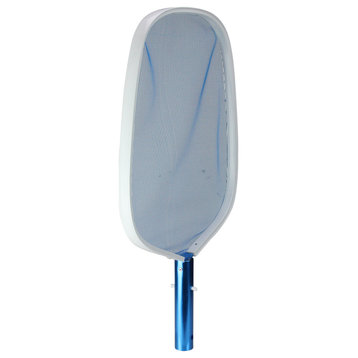
19.75" White and Blue Pool Leaf Skimmer With Nylon Netby Pool Central
$23
Is mother nature turning your pool into a leafy hodgepodge? Not to worry our pool leaf skimmer will take care of this mess! Mainly hallmarking on a durable netting it features a sturdy handle and an even stronger frame. Who doesn't love a fresh dive! Features:
- Leaf skimmer features an aluminum handle
- Comes with a durable nylon net
- Thick and sturdy molded frame
- Easy to clean pesky leaves and debris a breeze Dimensions: 19.75" high x 11.75" wide
- Material(s): plastic/aluminum Note: pole is not included
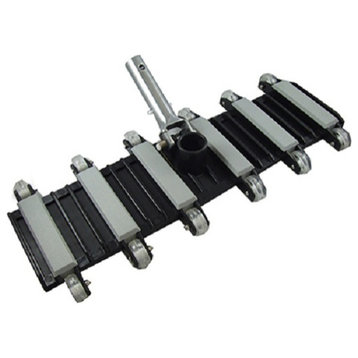
JED Pool Tools 30-167 Professional Flexible Concrete Pool Vacuum, 19"by JED Pool Tools
$57
Free Shipping
Professional 19" flexible concrete pool vacuum fits 1-1/2" Vacuum hose. Extra weights and deluxe wheels.
- Professional
- Flexible concrete pool vacuum fits 1-1/2" hose
- 19" wide vaccum
- Extra weights and deluxe wheels.
Best Seller
JED Pool Tools 00-IT492-01 7-Factor Test Strip, 50-Countby JED Pool Tools(9)
$22
Free Shipping
Tests for 7 factors as free chlorine, bromine, total chlorine, alkalinity, pH, total hardness and cyanuric acid.
- 50 Test strips
- Just dip and read
- For pool and spa
- Tests for 7 factors as free chlorine, bromine, total chlorine, alkalinity, pH, total hardness and cyanuric acid
- Made in USA.
Best Seller
JED Pool Tools 40-386 Pro-Series Leaf Pool Rake with Bagby JED Pool Tools(8)
$35
Free Shipping
Large aluminum frame and deluxe handle. Soft vinyal replaceable rim and bag. Pool rake with bag is ideal for cleaning debris, insects and leaves from the top of your pool or spa.
- Pro-series
- Large aluminum frame and deluxe handle
- Soft vinyal replaceable rim & bag
- Pool rake with bag is ideal for cleaning debris, insects & leaves from the top of your pool or spa.
JED Pool Tools 70-274 Algae Pool Brush, 10"by JED Pool Tools
$24
Free Shipping
Wide head with steel bristles to remove tough algae in plaster pools. 1-piece. 6" die cast aluminum handle.
- Size: 10"
- 1-piece
- Wide head with steel bristles to remove tough algae in plaster pools
- 6" die cast aluminum handle.
Best Seller
JED Pool Tools 10-450 Deluxe Floating Chlorine Tablet Feeder Dispenser, 8"by JED Pool Tools(4)
$24
Free Shipping
Deluxe 8" floating chlorine tablet feeder dispenser. Features adjustable ring and can be used with 1" or 3" tablets.
- 8" floating chlorine tablet feeder dispenser.
- Adjustable ring
- Holds 1" or 3" tablets
- Made in USA.
JED Pool Tools 10-451 Mini Floating Chlorine/Bromine Dispenser, Refillableby JED Pool Tools(15)
$17
Free Shipping
Refillable dispenser automatically releases bromine for convenient use in spas and hot tubs.
- Floating
- Mini chlorine/bromine dispenser
- Refillable dispenser automatically releases bromine
- Ffor convenient use in spas and hot tubs.
Vidaxl 2 Piece Pool Maintenance Kitby vidaXL LLC
$55
Free Shipping
vidaXL 2 Piece Pool Maintenance KitvidaXL 2 Piece Pool Maintenance Kit - 91741, This multi-functional pool maintenance kit is indispensable for keeping your pool clean. This pool cleaning kit is made of durable and corrosion-proof materials. The underwater vacuum cleaner is perfect for above ground pools, spa, ponds and fountains. Thanks to the removable and reusable debris and leaf collection bag, the skimmer can pick up even the smallest debris. The aluminium poles have 5 sections, enabling you readily to adjust the length according to your needs. Delivery includes 1 leaf skimmer and 1 underwater vacuum cleaner.
- Model No : 91741
- Brand : vidaXL
- Material: ABS
- Pole length: 47.2"
- 5-section aluminum pole
- For use with all above ground pools except steel wall pools
- Delivery includes 1 leaf skimmer and 1 underwater vacuum cleaner
Vidaxl 4 Piece Pool Maintenance Kitby vidaXL LLC
$176
Free Shipping
vidaXL 4 Piece Pool Maintenance KitvidaXL 4 Piece Pool Maintenance Kit - 91739, This multi-functional pool maintenance kit is indispensable for keeping your pool clean. This pool cleaning kit is made of durable and corrosion-proof materials. Meanwhile, a large shaped white ABS weighted vacuum with protective vinyl bumper and side brushes is easy for clean. Thanks to the removable and reusable debris and leaf collection bag, the skimmer can pick up even the smallest debris. Thanks to the adjustable aluminium pole, it provides you the means of changing the pole's height according to your needs. Delivery includes 1 vacuum, 1 skimmer, 1 aluminium pole and 1 blue hose.
- Model No : 91739
- Brand : vidaXL
- Material: ABS
- With a blue hose
- Hose diameter: 0.15"
- Hose length: 315"
- Aluminum pole height adjustable from 47.2" to 141.7"
- Large shaped weighted vacuum with protective vinyl bumper and side brushes
- Removable and reusable debris and leaf collection bag
- For use with all above ground pools except steel wall pools
Delivery included:
- 1 x Vacuum
- 1 x Skimmer
- 1 x Aluminum pole
- 1 x Blue hose
Best Seller
WHIRLAWAY Whirlpool Bath System Cleaner and Deodorizer, Hot Tubs & Spas, 8 Ozby Chemique(2)
$14
Free Shipping
Whirlaway is a whirlpool bath system cleaner and deodorizer formulated for the safe and efficient cleaning, deodorizing, and stain removal of internal bath circulation systems. When used regularly, Whirlaway eliminates odors and corrosion-causing sulfides and cleans internal piping of soap scum, mineral deposits, mold, mildew, algae, and bath and body oils that cause bacteria growth. Using a cleaner on your whirlpool tub at least once a month is recommended, to keep it clean and free of contamination.
FEATURES:
- WhirlAway can be safely used in all plumbing systems, will not harm or mar acrylic, fiberglass, ABS
- WhirlAway does not contain any chlorine compounds or hypochlorite bleaches.
- It solubilizes, emulsifies contaminates such as soap scum, bath oils, body oils, mold, mildew, etc
- WhirlAway is environmentally safe, 100% biodegradable.
- Available in 8 oz. and 32 oz. varieties
DIRECTIONS:
Fill bath with hot water 1"-2" above the highest jets. Turn on the circulation pump and slowly pour 8 ounces of WhirlAway near the suction intake. Circulate solution for approximately 5 minutes. Turn off the pump and completely drain the tub. Refill the tub with cold water and circulate for 2-3 minutes. Drain the tub again. System is now clean, deodorized and ready to use.Best Seller
6" Water Line Sponge Scrub Pad Head with Fillable Detergent Tankby Pool Central(22)
$23
- Scrub away those unsightly water lines with this pool scrub pad
- This heavy duty brush has the strength to attack algae with a coarse pad that leaves no filth behind
- Scrubber attaches to any standard pole (1.25") for easy reach and no bending
- Pole slides over the handle and is secured with a V-clip
- The included chamber holds detergent for a spotless clean Overall dimensions: 11"L x 5.5"W x 4.75"H
- Pad: 6"L x 5.5"W x 1.5"D
- Material(s): plastic/foam Note:Pole not included - scrubber head only
9.75" Blue Stainless Steel Algae Brush for Cement Poolsby Pool Central(5)
$18
Cleaning your pool would be effortless with this stainless steel algae brush. No more stress about cleaning your pool walls with this curved wall brush. Make your cleaning jobs easier than ever before. Features:
- Brush features stainless steel bristles
- Comes with a handle that is easy to attach to your telescopic pole
- Perfect for cleaning your above ground or in ground pool Dimensions: 5.5" high x 9.75" wide
- Material(s): plastic/metal Note: does not come with a pole
Jed 30-171 Weighted Vinyl Pool Vacuumby JED Pool Tools, Inc.(1)
$33
Free Shipping
"JED POOL TOOLS, INC." WEIGHTED VINYL POOL VACUUM
- Weighted rectangular vacuum with brushes and protective bumper around entire perimeter
- Fits 1-1/4'' and 1-1/2'' vacuum hose and standard pool poles.
- FOR VINYL LINERS
Best Seller
JED Pool Tools 40-363 Deluxe Leaf Skimmer Head with Aluminum Handleby JED Pool Tools(6)
$28
Free Shipping
Sturdy plastic frame with aluminum handle and fine mesh basket. Ideal for cleaning leaves, insects, and debris from the top of your outdoor pool or spa. Poly bag with header.
- Sturdy plastic frame
- Aluminum handle and fine mesh basket
- Ideal for cleaning leaves, insects, & debris from the top of your outdoor pool or spa
- Poly bag with header.
JED Pool Tools 40-365 Professional Aluminum Leaf Skimmer, X-Largeby JED Pool Tools
$33
Free Shipping
Professional grade, heavy duty aluminum frame and deluxe handle. Replaceable plastic frame and nylon net. Extra large.
- Professional grade
- Extra large
- Heavy duty aluminum frame
- Deluxe handle
- Replaceable plastic frame and nylon net.
12.5" Above-Ground Swimming Pool Standard Wall Skimmerby Pool Central
$54
Free Shipping
Dive into crystal-clear waters with this swimming pool wall skimmer. This essential pool accessory brings convenience and efficiency to your pool maintenance routine. Designed to fit above-ground pools its sleek white finish seamlessly blends with your pool's aesthetics. The skimmer's size allows for efficient water flow capturing debris and leaves before they settle at the bottom of your pool. The design ensures optimal performance so you can enjoy more time swimming and less time worrying about maintenance. Product Features:
- Standard swimming pool wall skimmer
- For above ground pools
Easy assembly required Includes:
- Cover
- Vac plate
- Basket with plastic handle
- Weir
- Hose Adaptor
- Double layer gasket
- Face plate
- Screws Overall Dimensions: 12.5"H x 7.25"W x 9.25"D
- Material(s): plastic/pvc
3 Butterfly Clips for Swimming Pool Pole Attachmentsby Pool Central(13)
$14
- These butterfly V clips help with all sorts of pool attachments like nets vacuums and brushes
- Snap-in clips
- Easy to attach Dimensions: 2"H x 1.75"W x 0.25"D
- Material(s): plastic Note: set includes 3 individual clips
Jed Pool Vacuum Splasher With Aluminum Handle, 4'by JED Pool Tools, Inc.(55)
$34
Free Shipping
Highlights:
- Splasher - for pools.
- Quick, easy cleaning for above ground pools, spas, ponds, foundations and spot cleaning large pools.
- Works using your garden hose pressure.
- Comes with 4' aluminum handle, hose adapter and reusable vacuum bag.
JED Pool Tools 60-640-050 Deluxe Transparent Blue Backwash Hose, 1-1/2' x 50'by JED Pool Tools(3)
$28
Free Shipping
Lightweight and collapsible. Specially treated UV inhibitors to prevent deterioration caused by sunlight. Lies flat for easy storage. Transparent design.
- 1-1/2" x 50'
- Lightweight and collapsible
- Specially treated UV inhibitors to prevent deterioration caused by sunlight
- Lies flat for easy storage
- Transparent design
- Shrink wrapped.
INTEX Vacuum Hose Pool Hose Vacuum Cleaner Hose Swimming Pool Hose White 70.9"by INTEX
$46
Free Shipping
Do you have to bridge a considerable distance to the pool from your filter pump or pool heating? This Intex pool hose is a perfect choice. The hose has a diameter of 1.5", a length of 70.9" and is equipped with an internal thread connection. You can cut out the pipe according to your needs.
- Color: White
- Material: Plastic
- Diameter: 1.5"
- Length: 70.9"
- With Φ2" internal thread connection
- Intex number: 90634
- California Proposition 65
- Warning: Cancer and Reproductive Harm – www.P65Warnings.ca.gov.
vidaXL Automatic Chlorine Feeder for Swimming Pool Chlorine Dispenser for Spaby vidaXL LLC(72)
$49
Free Shipping
This automatic chlorine feeder is designed for installation next to your filter system. It is operated by the pressure differences of your system which draws water through the feeder. The control dial is easy to use and lets you adjust the rate of distribution. By regulating the valve setting between FULL (more chlorine) and OFF (less chlorine), you can easily adjust the chlorine feed amount to maintain the proper chlorine residual in your pool.
- Color: Black
- Pipe size: 1.5" female thread
- Volume capacity: 3354.9 ft³ max.
- Dimensions: 14.1" x 8.1"
Best Seller
JED Pool Tools 60-345-06 1-1/2x6 Deluxe Filter Connection Hose, 1-1/2" x 6'by JED Pool Tools(28)
$27
Free Shipping
Flexible spiral wound hose with cuff. 1 1/2" x 6' filter connection hose.
- Flexible
- Spiral wound hose with cuff
- 1 1/2" x 6' filter connection hose
- Made in USA.
Blue Spiral Wound Vacuum Swimming Pool Hose with Swivel Cuff 18' x 1.25"by Pool Central
$28
Free Shipping
Designed for water disposal during vacuum cleaning, this hose is made of a quality plastic that holds up to extreme weather. Use a swivel cuff to prevent tangles! Each hose rolls up neatly for storage and fits most standard vacuum heads.
Features:
- Fits most standard vacuum heads
- Swivel cuff prevents tangles
- Lightweight, flexible and it floats
- Dimensions: 18' long x 1.25" diameter
- Material(s): plastic
vidaXL 11 Piece Wide-mouth Pool Skimmer Pool Cleaning Set Pool Vacuum Cleanerby vidaXL LLC
$89
Free Shipping
This wide-mouth pool skimmer is designed for varying above ground pool application. This pool cleaner is made of heavy-duty ABS, enabling it UV and weather resistant. The contoured body, combined with the weir and a basket, outfits superior skimming action that removes debris more efficiently and completely. Delivery includes 1 skimmer, 1 wide mouth, 1 skimmer weir, 1 skimmer cover, 1 inlet nozzle, 1 basket, 1 adaptor, 1 hose connection, 3 face plates and other mounting accessories.
- Color: White
- Material: ABS
- Dimension: 13.5" x 9.8" x 12"(W x D x H)
- Mouth size: 13.5" x 7.6" (L x W)
- UV and weather resistant
Delivery included:
- 1 x Skimmer
- 1 x Wide mouth
- 1 x Skimmer weir
- 1 x Skimmer cover
- 1 x Inlet nozzle
- 1 x Basket
- 1 x Adaptor
- 1 x Hose connection
- 3 x Face plate
- Other mounting accessories
JED Pool Tools 70-286 All Purpose Scrubber, Single Padby JED Pool Tools
$18
Free Shipping
For use in pools, spas, hot tubs, fiberglass, acrylic, ceramic tile and non-painted surfaces.
- Single pad
- For use in pools, spas, hot tubs
- Fiberglass, acrylic, ceramic tile & non-painted surfaces.
Automatic Off-Line Chlorinator Chemical Feeder, 86lb Capacityby Northlight Seasonal
$258
Free Shipping
Efficient and maintenance-free, our durable corrosion-proof automatic chlorinators are ideal for new or existing pools or spas and work automatically with your pump and filter system. This automatic off-line chemical feeder is completely enclosed therefore there are no escaping fumes and it doesn't require any special venting. The easy-to-use integral dial control valve lets you accurately adjust the rate of chlorinating needed to keep your pool and spa sanitized. Off-line chlorinators are especially important when there is no room to plumb an in-line chlorinator properly or conveniently, and they are easily installed.
Product features:
- Off-line chemical feeder
- 86lb tablet capacity
- For use with 3" slow dissolving chlorine tablets
- Dial control valve lets you control and adjust the rate of feed
- Threaded cover for safe and convenient access to add tablets
- Corrosion resistant construction for long lasting life
- Enclosed system
- No special venting required
- Fits off-line to most PVC
- Simple and easy installation
- Pressure gauge up to 50 PSI
- Max output: 86lbs/hr
JED Pool Tools 40-389 Pro Series Deep Leaf Rakeby JED Pool Tools
$43
Free Shipping
Highlights:
- Deep leaf rake
- Heavy duty aluminum frame
- Deluxe enameled aluminum ez clip handle
- Replaceable plastic rim
- Deluxe deep replaceable puncture correctable pp mesh bag
JED Pool Tools 80-852 Skimmer Basket Sockby JED Pool Tools
$21
Free Shipping
Highlights:
- Skimmer basket sock
- Traps bugs, pollen, hair
- Pine needles & smell debris before damaging the pump & filter system
- Fits all standard in ground or above ground skimmer baskets
- Easy to install & re-useable
Best Seller
36'' Blue Nylon Bristle Pool Wall Brush With Aluminum Handleby Pool Central(21)
$41
This nylon bristle pool wall brush is just the thing to make cleaning quicker and easier. Use this brush effectively to remove corner dirt with ease. No more stress about cleaning your pool walls with this curved wall brush. Features:
- Brush features nylon bristles
- Aluminum handle ensures durability and easy connection
- Perfect for cleaning your above ground or in ground pool Dimensions: 5.5"H x 36" L x 7"W
- Material(s): plastic/aluminum Note: does not include pole
If you’re lucky enough to own a pool once the weather warms up — or a hot tub for those cool summer evenings — you’ll know that keeping your water clean is the key to some fun in the water. Without handy pool cleaners and chemicals, debris and algae can build up and your pool water balance can be thrown off. Read on for some tips on selecting the right pool chemicals and cleaners to keep your water sparkling.
Properly balancing your pool water involves monitoring and adjusting three measurements as needed: alkalinity, calcium hardness and pH. As with any chemicals, be sure to keep yours in a safe place out of the reach of children and animals.
• Alkalinity: The level of alkalinity has a major effect on the condition of your pool’s water. If your alkalinity is too low, it may cause skin irritation. When you begin to adjust the alkalinity of your pool, keep in mind that 1.5 pounds of these chemicals per 10,000 gallons of pool water will raise your alkalinity level by approximately 10 parts per million, or ppm. As an example, when your alkalinity levels are below 80 ppm or your pH level is below 7.4, consider increasing your alkalinity levels.
• Calcium hardness: This measurement tells you how much calcium is in your pool water. Low levels can actually create corrosive water. The rule for altering your calcium hardness is that about 5 pounds per 10,000 gallons of water will raise calcium hardness by approximately 40 ppm. If your calcium hardness falls below 150 ppm you should use a calcium hardness increaser.
• pH: An optimal level for your pool water pH is between 7.4 and 7.6. The pH level of your pool may fluctuate often, so it’s a good idea to have both a pH increaser and a pH reducer on hand. The general rule for pH altering chemicals is:
• To increase your pH, you should first use about 1 pound of pH increaser per 10,000 gallons of water.
• To reduce your pH, you should first use no more than 6 ounces per 10,000 gallons of water.
Along with pH, alkalinity and calcium hardness affecting chemicals, you should also have sanitizers on hand. These include:
• Chlorine: To rid your water of bacteria, viruses and fungi, you’ll need chlorine. Chlorine tablets can be added manually and tend to work very quickly. You’ll want to dose your water with 1 to 3 ppm.
• Bromine: Another way to kill bacteria, viruses and fungi, bromine tends to work much better than chlorine and is more effective in hot water. This chemical tends to break down slower than chlorine, so you may need a chemical feeder to distribute it. Bromine is also less irritating for your eyes and skin, making it an ideal choice. If you do add bromine to your pool, the ideal amount is 3 to 5 ppm.
When not in use, be sure to store your chlorine or bromine in a safe place that’s out of reach of children and animals.
Along with properly balanced chemicals, your pool will benefit from a set of pool cleaners. These typically come in manual or automatic designs and can be used to clean up fallen leaves, dirt and other debris. When it comes to cleaners, you’ll most likely have a choice of:
• Vacuum: A pool vacuum connects to the intake pipe of your pool filter via a hose. The vacuum head is typically on wheels and attached to a telescoping pole to allow you to reach those deep corners. To vacuum your pool, you should place the vacuum into the water so the hose end is under water. This will allow it to fill with water before you connect it to the vacuum head. Once your hose is connected, you should slowly move the vacuum over the bottom and sides of your pool — just like vacuuming a floor.
• Skimmer: A pool skimmer compliments a pool vacuum by grabbing debris off the surface of the water. It also features a telescoping pole and a lightweight net on the end. It’s recommended that you skim your pool daily, plus before and after a swim. By skimming regularly, you can save energy by keeping debris out of your filter.
• Robotic pool cleaner: A robotic pool cleaner features a motor with a drive, pump and processor. By pulling water in through the pump and sending it through attached filter bags before pumping it back out, the robotic cleaner can easily remove debris. Your robotic pool cleaner should feature bumpers that allow it to safely and gently bump into edges. Once the robot bumps into an edge, it will change direction until the entire pool has been cleaned.
How can pool chemicals keep my pool water balanced?
Properly balancing your pool water involves monitoring and adjusting three measurements as needed: alkalinity, calcium hardness and pH. As with any chemicals, be sure to keep yours in a safe place out of the reach of children and animals.
• Alkalinity: The level of alkalinity has a major effect on the condition of your pool’s water. If your alkalinity is too low, it may cause skin irritation. When you begin to adjust the alkalinity of your pool, keep in mind that 1.5 pounds of these chemicals per 10,000 gallons of pool water will raise your alkalinity level by approximately 10 parts per million, or ppm. As an example, when your alkalinity levels are below 80 ppm or your pH level is below 7.4, consider increasing your alkalinity levels.
• Calcium hardness: This measurement tells you how much calcium is in your pool water. Low levels can actually create corrosive water. The rule for altering your calcium hardness is that about 5 pounds per 10,000 gallons of water will raise calcium hardness by approximately 40 ppm. If your calcium hardness falls below 150 ppm you should use a calcium hardness increaser.
• pH: An optimal level for your pool water pH is between 7.4 and 7.6. The pH level of your pool may fluctuate often, so it’s a good idea to have both a pH increaser and a pH reducer on hand. The general rule for pH altering chemicals is:
• To increase your pH, you should first use about 1 pound of pH increaser per 10,000 gallons of water.
• To reduce your pH, you should first use no more than 6 ounces per 10,000 gallons of water.
What pool chemicals do I need to sanitize my pool?
Along with pH, alkalinity and calcium hardness affecting chemicals, you should also have sanitizers on hand. These include:
• Chlorine: To rid your water of bacteria, viruses and fungi, you’ll need chlorine. Chlorine tablets can be added manually and tend to work very quickly. You’ll want to dose your water with 1 to 3 ppm.
• Bromine: Another way to kill bacteria, viruses and fungi, bromine tends to work much better than chlorine and is more effective in hot water. This chemical tends to break down slower than chlorine, so you may need a chemical feeder to distribute it. Bromine is also less irritating for your eyes and skin, making it an ideal choice. If you do add bromine to your pool, the ideal amount is 3 to 5 ppm.
When not in use, be sure to store your chlorine or bromine in a safe place that’s out of reach of children and animals.
What kinds of pool cleaners can I use in my swimming pool?
Along with properly balanced chemicals, your pool will benefit from a set of pool cleaners. These typically come in manual or automatic designs and can be used to clean up fallen leaves, dirt and other debris. When it comes to cleaners, you’ll most likely have a choice of:
• Vacuum: A pool vacuum connects to the intake pipe of your pool filter via a hose. The vacuum head is typically on wheels and attached to a telescoping pole to allow you to reach those deep corners. To vacuum your pool, you should place the vacuum into the water so the hose end is under water. This will allow it to fill with water before you connect it to the vacuum head. Once your hose is connected, you should slowly move the vacuum over the bottom and sides of your pool — just like vacuuming a floor.
• Skimmer: A pool skimmer compliments a pool vacuum by grabbing debris off the surface of the water. It also features a telescoping pole and a lightweight net on the end. It’s recommended that you skim your pool daily, plus before and after a swim. By skimming regularly, you can save energy by keeping debris out of your filter.
• Robotic pool cleaner: A robotic pool cleaner features a motor with a drive, pump and processor. By pulling water in through the pump and sending it through attached filter bags before pumping it back out, the robotic cleaner can easily remove debris. Your robotic pool cleaner should feature bumpers that allow it to safely and gently bump into edges. Once the robot bumps into an edge, it will change direction until the entire pool has been cleaned.






